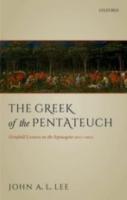
Oxford (2018) h/b 384pp £75 (ISBN 9780198816133)
Biblical Greek studies are far too infrequently taken up by classicists. As L. points out, his work bridges several disciplines, and as such, it is a refreshing read. If readers can bear with the technical challenges that interdisciplinary work inevitably brings, then they will be well-rewarded with a richer understanding and enthusiasm for the Pentateuch as a text, and Greek as a language.
L. opens by discussing the evidence used in thinking about the Greek of the Pentateuch, drawing out how useful technological developments such as the TLG, Accordance (or equivalent software) and sites such as http://papyri.info/ have been in increasing the availability of texts for comparison. This has been especially important in contextualising ‘biblical Greek’ (however one defines that) as part of the ongoing spectrum of Koine, rather than as some sacred language in its own right.
Through the remaining chapters he uses this evidence to demonstrate why he thinks that the Pentateuch was written by a group of translators (probably five), working in collaboration, with native Greek, educated to a high level (but possibly not the highest). He discusses the Greek as a word-for-word isomorphic translation written in ‘mid-level’ Koine but demonstrating literary flourishes. Chapter 2 discusses this with reference to tone and style, chapter 3 gives evidence for the educated nature of the language, and chapter 4 situates it as idiomatic Greek with only limited interference from Hebrew (as opposed to bad Greek aping Hebrew). Chapter 5 (not from the lecture series) sets out his arguments for collaboration, and in contrast chapter 6 demonstrates the freedom of choice the translators of each book employed.
Each chapter finishes with a short summary collating and consolidating the points made. This is a helpful overview, given the large quantities of data used to exemplify each point. The short (new) ‘Conclusions’ chapter then brings together these summaries rather than adding a conclusion, as the book is more a discussion than an argument.
The chapters follow an easy rhythm and regular length, as suggested by their original format as lectures. Where material has been reused, this is noted in the footnotes. Footnotes provide some bibliographical links, but the seventeen-page bibliography is more extensive than notes would suggest, and would be useful for anyone wanting to broaden their knowledge.
Chapters contain many examples, and much ‘working out’. For the general reader, this can get in the way of the main narrative, but for the specialist, it is helpful to see the detail. Where the ‘data’ is longer than would fit well in the chapter, it is moved to one of eight appendices. There is also a useful index of Greek and Hebrew terms.
The book couches itself as accessible to a reader with general interest. It is written in an informal and conversational style which is indicative of its origin as public talks. It is, however, also extremely technical and specialist, which may limit its appeal. Passages of Greek and Hebrew are translated, but shorter extracts are not, and given the high content of untranslated Greek and Hebrew, some knowledge of both is needed. The same is true of grammatical and linguistic terms, including for example the extended discussion of the Hebrew infinitive absolute, a construct which will be unfamiliar to most people. The Letter of Aristeas frames the book and provides a focus to the conclusion, but needs more elaboration, given that the majority of readers will be unfamiliar with it.
This is an interesting and engaging book for anyone who wants to wallow in the mechanics of Greek, with an interest in the Pentateuch. It contains much material for those who want to consider uses of the Pentateuch (and indeed Septuagint) in the New Testament. The book pays homage to Greek, and is a delight for any enthusiast to read. At several points, L. mentions topics which he will not be taking up, which gives this book a further sense of acting as a rallying cry to leaders to take up the topic so evidently close to his heart.
On the whole, the book is well presented. My copy had a few issues with badly-set pages, but there are minimal typos. The Greek is in a small font, and at least partly italicised, which can make it hard to follow. Important words are in bold, whereas in Hebrew (already in bold type) they are underlined, which sometimes makes following examples a little awkward.
Cressida Ryan
